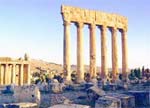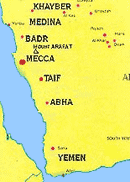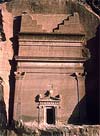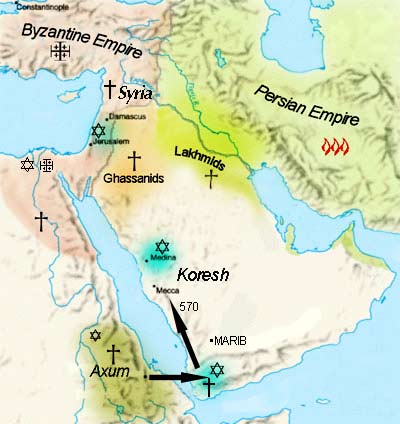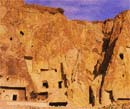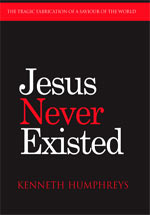A Pagan Heart
Damascus
It seems that a 13-year-old Muhammad visited the markets of Bostra and Damascus with his uncle.
The development of wealthy 'caravan cities' threatened the primitive egalitarianism of the Arabian tribes.
With the creation of settled towns new wealth was concentrated into a few hands, where previously everyone had been at a similar economic level. Tribal loyalties were put under strain.
At the same time contact with foreign cultures introduced temptations and new beliefs – causing traditional religions to be questioned.
Into this mix of instability and dissatisfaction an ex-caravaneer Muhammad introduced his 'revelation.'
Arabian Al-Uzza - as fish goddess
Open Marriage?
Both polygamy and polyandry were practised in pre-Islamic Arabia, as well as 'temporary marriage.'
Muhammad, in the rules for his community ('umma') insisted on restricting the free-for-all and greater care of widows and orphans – perhaps because he was one himself.
In later life Muhammad would take both a Coptic Christian and a Jewish wife and – in a remarkable self-serving 'revelation' – received special permission from God to marry not only the wife of his adopted son Zayd but any other woman that took his fancy.
"A believing woman if she give herself unto the Prophet and the Prophet desire to ask her in marriage - a privilege for thee only, not for the other believers - We are Aware of that which We enjoined upon them concerning their wives and those whom their right hands possess - that thou mayst be free from blame, for God is ever Forgiving, Merciful." (Surah 33.50) |
Last of the Great Pagan Cities
Temple of Jupiter, Baalbek (modern Lebanon) – largest and most ornate temple in the Roman world. 6 columns remain of an original 54.
The temple faces east, towards the sun. The courtyard featured 12 circular meeting places for sacred meals.
Despite Christian persecution, Baalbek remained a centre of recalcitrant paganism into the Islamic era.
Baalbek: Umayyad Mosque – built across the Roman forum with reused Roman columns.
'Tell them, My Lord has directed me to a path that is straight, a supreme law, the creed of Abraham the upright who was not an idolater.' (Surah 6.161) |
Islam's early battle grounds
The sword was a necessary instrument in convincing the doubtful.
Yemen
Caravans from the south carried religious ideas as well as spices – as verses in the Koran confirm.
The Koresh of Mecca were in perpetual conflict with the Hawazin for control of the perfume trade. Decline of Yemen followed the collapse of the Marib dam.
About 570 AD the kings of Yemen, conquered by the Ethiopians of Axum, appealled to Khosrau I (531-579) for help. He sent a fleet and an army, expelled the Ethiopians and installed a Persian governor in the Yemen.
No Jiggling!
8th century topless figure from Umayyad palace Khirbat al Mafjar, Jericho, Palestine.
Part of Muhammad's message was for women to 'cover their adornment.'
'And tell the believing women ... to draw their veils over their bosoms, and not to reveal their adornment save to their own husbands or fathers or husbands' fathers ... And let them not stamp their feet so as to reveal what they hide of their adornment.' (Sura 24.31) |
Influence from India
Carved between 100 BC - 100 AD, the Nabatean temples of Madain Saleh (northwest Arabia) show Indian Vedic influence.
Old Wine in New Bottles – The Genesis of Islam
Although the Hejaz (western Arabia) itself was never colonised it had been affected by the migrations of peoples and the vagaries of the caravan trade. With the rise of maritime trade and the decline of Arabia's overland caravan traffic, tribes that had settled in the oases either migrated elsewhere or reverted to nomadism. The towns themselves were abandoned. By the 6th century the ancient southern and northern kingdoms of the peninsular were well into decline, with many of their clans migrating to the border lands of Byzantium and Persia. Though weakened by war and pestilence, and with their frontier provinces wrecked, neither Persia nor Byzantium perceived the fragmented tribes of Arabia as any threat and hired the new arrivals as 'frontier guards' and mercenaries.
Justinian's Legacy Part of the ruinous legacy of the Christian monarch Justinian (527-565) directly favoured the rise of Islam. The Persian wars had disrupted the 'Silk Road' from Hamadan to Antioch and Justinian's plan was to re-route Asian trade north of the Caspian Sea (he sent emissaries to the Turks of Transoxia), but the arrival of Avars from central Asia scuttled that idea. Justinian, pre-occupied with the reconquest of the west, withdrew Roman shipping from the Red Sea. To keep the trade route open he relied upon diplomatic pressure on the Ethiopians. Unfortunately, what remained of maritime trade was catastrophically affected by plague rats arriving from East Africa. War in Mesopotamia and the decline of Red Sea shipping once again gave a fillip to the caravan route along the Hejaz. Only one caravan town was in a position to respond to the opportunity: Mecca.
'The Days of Ignorance' Mecca, dominated by the Koresh tribe, was the one Arabian town enjoying any sort of prosperity in the 6th century. The sanctuary of the Kaaba, centre of an annual pilgrimage and pan-tribal market, benefitted from a lively livestock and slave trade, as well as the multi-faith shrine itself. But it was a wild 'frontier' town, rife with alcoholism, prostitution, profiteering and idol-worship. Muhammad ibn Abdallah ('an original and superior genius' – Gibbon), born into the Koresh Banu Hashim clan, became an affluent but disaffected urban merchant who saw virtue in the puritanical tribal values of the desert nomads. Though orphaned when a boy Muhammad had the good fortune to be raised by a grandfather who happened to be head of the ruling clan of Mecca. As a young man he worked the caravan trade and married his employer, a wealthy widow. Doubly blessed, Muhammad had the leisure time to ponder the nature of the gods and plan his career.
In mid-life, this ordinary Arab merchant assumed the mantle of cultic leader and self-styled prophet. Not surprisingly, the wider population of Mecca either ignored or derided his prophetic pretensions. Frustrated and yet fortified by the rejection, Muhammad and some of his loyal cult members retreated to the rival town of Yathrib (Medina). Others crossed the Red Sea to take up residence in the Christian kingdom of Axum. In Yathrib fierce inter-tribal warfare allowed 'Muhammad the holy man' to take on a role of 'arbitrator.' Emerging from the conflict as a prominent religious leader Muhammad could now formulate serious political ambition and a reckoning with the Meccan establishment. Combining in his own person both religious and military leadership he could now strike back at the skeptics and rejectors of his prophetic status by deploying a private army and singling out critics for assassination or execution. From his base at Medina, several years of banditry won Muhammad a large following. For eight years, until 630, he raided the Meccan caravans and imposed an alms tax ('zakat') on the tribes. Ultimately, he would plunder the pagan riches of the shrine at Mecca.
'The Prophet': Caesar AND Pope Muhammad's 'Islam' was eclectic and opportunistic. The religious influences upon 7th century Arabia were myriad. All represented a higher civilization than Arabia's tribal society which must have distressed the zealot. Maintaining that, over the course of twenty two years, he communed with an angel, Muhammad borrowed freely from the older faiths to fashion a monotheistic religion adapted for the tribal society of Arabia fused with an ideology of divinely sanctioned conquest. In Muhammad's day Judaism and Christianity had been long established among the Arabs, the Jews for centuries and in considerable numbers after the Roman wars, and the Christians from the mid-2nd century. Missionaries and proselytisers, they had converted whole tribes of Arabs to their cause. As with the German tribes of Europe, faith was not an article of individual conviction but a tribal allegiance and by the 6th century there were Jewish tribes and Christian tribes. In Medina, Muhammad lived among Jews and had an intimate acquaintance with Judaism. He also either encountered or received at second hand knowledge of diverse and heretical Christian sects. When Muhammad failed to convince the Jews of Medina that he was the latest (and last) prophet he turned against them, maintaining that they had distorted their own Bible. In 624 Muslim prayer mats were turned from facing Jerusalem to facing Mecca. Two Jewish tribes were driven out and a third decimated. The plunder helped recruit Bedouin tribes to his cause. Eventually Meccan resistance collapsed, particular after Muhammad enshrined the old pagan pilgrimage to Mecca as a pillar of the new faith. Yet for all his successes the confederation inspired by Muhammad's charismatic personality – he welded together an unlikely coalition of ex-merchants, desert nomads, and agriculturalists – did not survive his death. Most Arabs, particularly the nomadic and semi-nomadic Bedouin, remained at heart polytheistic pagans and Muhammad's successor Abr Bakr (632-634) immediately had to crush a rival alliance of tribes in eastern Arabia, and even rival 'prophets'. Islam has been riven by sectarianism ever since.
A World Full of Gods Christians and Arabia
From Edessa the 'Nestorian' (aka the 'East Syrian Church' after the Synod of Beth Papat, 484) successfully evangelised in the east, seducing Persia's Lakhmid Arab mercenaries and establishing itself far into central Asia and China. The monophysite 'Jacobites,' much keener on the Blessed Virgin than the Nestorians, spread north to Armenia and south into Egypt (influencing the 'Copts'). They brought both the Ghassanid Arab mercenaries of Byzantium and the 'Judeo-Christian' tribes of Axum into the monophysite fold. The 'Chalcedonians,' known variously as Maronite (after 5th century monk Maron), 'Monothelite' ('one will in Christ' – a last minute attempt of Byzantine compromise) and 'Melkitesite,' were an Orthodox 'royalist' minority. Frontier towns like Edessa and Emesa were home to numerous exotic cults – Bardaisans, Arians, Messalians, Manicheans, Gnostics, Carpocratians, etc., a veritable cooking pot of 'faith'.
The kingdom of Abyssinia – Axum – had a presence on the Arabian coast from the 3rd century. In the 4th century, allied to Rome and newly converted to Christianity, their fervour inspired the conquest of the whole of the Himyarite kingdom of southern Arabia. A great church 'al-Qulais' was built in San'a. The Ethiopians campaigned as far north as central Arabia in 547. Later ejected by a Judaising Arab king, Dhu Nuwas of Himyar (518-525) – he offered the inhabitants the choice between Judaism and death – the Ethiopians re-invaded in 570 under Abraha. It was the year of Muhammad's birth. The Ethiopians failed to take Mecca, even with elephants, and shortly after were driven out of the Yemen and replaced by Persians. Ironically, it was to safety in Ethiopia that the earliest Muslims fled when life in Mecca looked threatening. Maybe the Axumites thought they were Christians?
Jews and Arabia
Jews arrived in Arabia at least as early as the 6th century BC, lured by prospects along the caravan routes. Ezekiel (27.19,22) catalogues trade between Yemen and the city of Tyre. Over the centuries they were joined by others, fugitives from Roman-Jewish wars and Christian purges. The Jews of the Levant welcomed and assisted the Persian invasion of 611-617 and when the Byzantines returned in 629 the Jews were again expelled from Jerusalem. In Mecca there were 3 Jewish clans: Beni Al Nadheer and Beni Qaynuqah expelled in 625; and the Beni Quraidha, brutally dealt with at Khayber in 627.
Persians and Arabia During Greek occupation Zoroastrian priests first fled to the deserts of Arabia. Sassanid Persians established a presence on the Arabian shore of the Gulf in the 4th century AD. Among their Arab allies were the powerful Lakhmids of northern Arabia. The official religion was Zoroastrianism but many exotic cults thrived, among them the Sabians (aka Mandaeans), a Gnostic sect which flourished in southern Babylonia. Muhammad's converts were at first called 'Sabians' by the Meccans. The Koran mentions the Sabians several times (22:17; 2:59; 5:73) and also the official priests, the Magians (22:17) Khusro II (590-628) made the mistake of subjugating the Lakhmids in 602. They broke free in 611 and readily joined the Muslim cause.
India and Arabia From the very earliest times the Himyar Kingdom of the Yemen received influences from India, along with the spices. Indian traders, both Hindu and Buddhist, settled in some of the major sea and river ports of the Arabian Peninsula, at the mouth of the Gulf of Aden on the island of Socotra and at Ubla, near modern-day Basrah at the head of the Persian Gulf. The Tarikh-i-Tabari, a 10th century history of Islam written in Baghdad by al-Tabari speaks of another group of Indians present in Arabia, the Ahmaras or 'Red-Clad People' from Sindh, probably saffron-robed Buddhist monks.
Sources:
Copyright © 2004
by Kenneth Humphreys. |
|||||||||||||||||||||||||||||||||||||||||||||||||||||||||||


